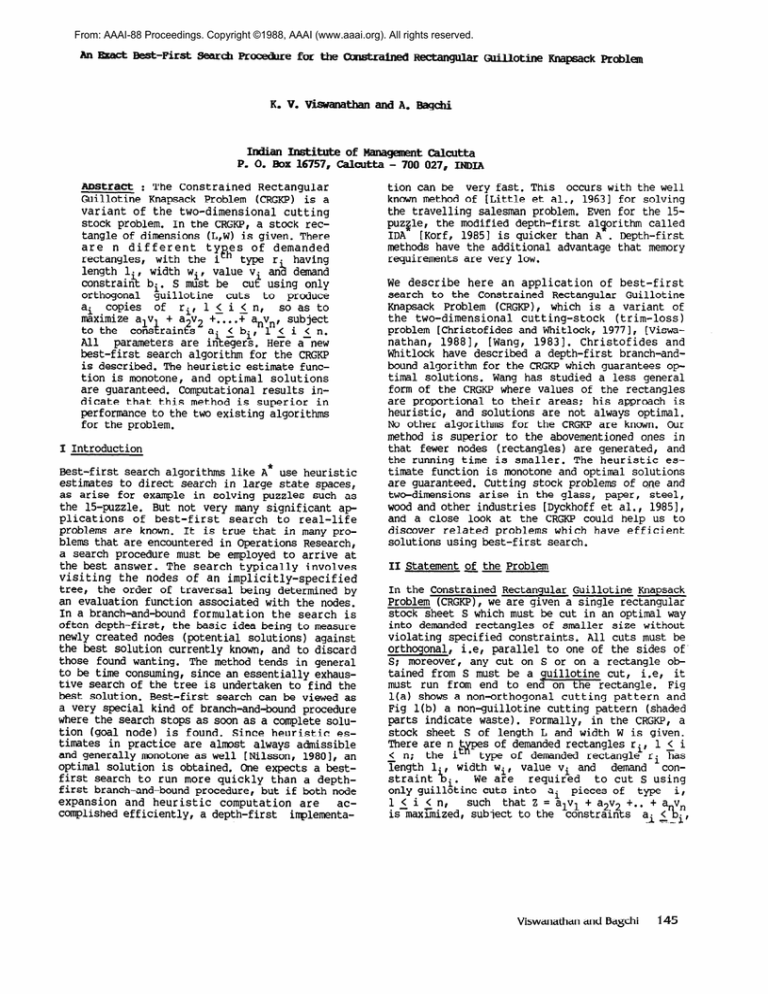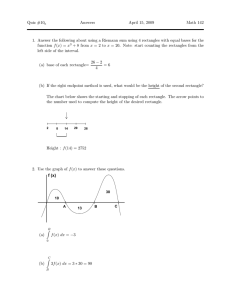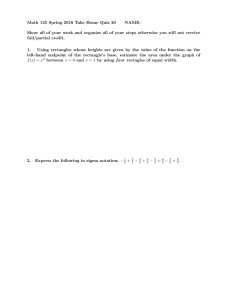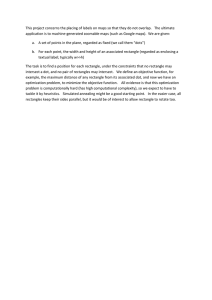
From: AAAI-88 Proceedings. Copyright ©1988, AAAI (www.aaai.org). All rights reserved.
ADstract : The constrained
Rectangular
Guillotine
Knapsack Problem (CRGKP) is a
variant
of the two-dimensional
cutting
stock problem. In the CRGKP, a stock rectangle of dimensions (L,W) is given. There
are n different
ty es of demanded
rectangles,
with the i eh
. having
length l:, width wi' value?e &% demand
constrai&
b. S must be cut! using only
orthogonal
&illotine
cuts to produce
a. copies Of rir lLiLnr
so as to
kximize a v + a2v2 ,':.;.;
aq.,; s;bje;t
to the co&sk raints
All
parameters are ir+tggeri: Here a-new
best-first
search algorithm for the CRGKP
is described. The heuristic
estimate function is monotone, and optimal solutions
are guaranteed. Computational results indicate that this method is superior
in
performance to the two existing algorithms
for the problem.
I Introduction
Best-first
search algorithms like A* use heuristic
estimates to direct search in large state spacesp
as arise for example in solving puzzles such as
the 15-puzzle. But not very many significant
ap
plications
of best-first
search to real-life
problems are known. It is true that in many problems that are encountered in Operations Research,
a search procedure must be empioyed to arrive at
the best answer. The search typically
involves
visiting
the nodes of an implicitly-specified
tree, the order of traversal
being determined by
an evaluation function associated with the nodes.
In a branch-and-bound formulation
the search is
often depth-first,
the basic idea being to measure
newly created nodes (potential
solutions)
against
the best solution currently
known, and to discard
I-hnna
-.*--u
fmmil
LVU..U
wm$-inr;.
The
mea&d
tends
iy,
p-pra?
to be time consuming, since an essentially
exhaustive search of the tree is undertaken to find the
best solution.
Best-first
search can be viewed as
a very special kind of branch-and-bound procedure
wnere cne search stops as soon as a compiete soiution (goal node) is found. Since heuristic
estimates in practice are almost always admissible
and generally monotone as well [Nilsson, 19801, an
optimal solution is obtained. One expects a bestfirst search to run more quickly
than a depthfirst branch-and-bound procedure, but if both node
expansion and heuristic
computation
are
accomplished efficiently,
a depth-first
implementa-
tion can be very fast. This occurs with the well
known method of [Little
et al.! 19631 for solving
the travelling
salesman problem. Even for the 15puzzle, the modified depth-first
alqorithrn called
IDA [Korf, 19851 is quicker than A . Depth-first
methods have the additional
advantage that memory
requirements are very low.
We describe here an application
of best-first
search to the Constrained Rectangular Guillotine
Knapsack Problem (CRGKP), which is a variant of
the two-dimensional
cutting-stock
(trim-loss)
problem [Christofides
and Whitlock, 19771, [Viswanathan, 19881, [Wang, 19831. Christofides
and
Whitlock have described a depth-first
branch-andbound algorithm for the CRGKPwhich guarantees optimal solutions.
Wang has studied a less general
-i- ---- where vaiues of the rectangles
form of the CRGKP
are proportional
to their areas: his approach is
heuristic,
and solutions are not always optimal.
No other algorithms for the CRGKPare known. Our
method is superior to the abovementioned ones in
that fewer nodes (rectangles)
are generated, and
the running time is smaller.
The heuristic
estimate function is monotone and optimal solutions
are guaranteed. Cutting stock problems of one and
two-dimensions arise in the glass! paper, steel,
wood and other industries
[Dyckhoff et al., 19851,
and a close look at the CRGKPcould help us to
discover related
problems which have efficient
solutions using best-first
search.
II Statement --of the Problem
In the Constrained Rectanqular Guillotine
Knapsack
-Problem (CRGKP), we are given a single rectangular
stock sheet S which must be cut in an optimal way
into demanded rectangles of smal.ler size without
violating
specified constraints.
All cuts must be
orthogonal,-i.e,
parallel
to one of the sides of
C.
‘IIVA.
bV. -A,,_ apay m1t Or! S Or O!? 22 reCtZlg2.e
Ob
%ned from S musi?& a guillotine
cut, i.e, it
must run from end to end on the rectangle.
Fig
l(a) shows a non-orthogonal
cutting
pattern
and
Fig l(b) a non-guillotine
cutting pattern -- (shaded
--parts indicate wastej. Formaiiy, in the cRGKpl a
stock sheet S of length L and width W is given.
of demanded rectangles ri, 1 ia:
Tie
arh; nit$xs
type of demanded rectangle ri
ieng;ih li, width WiI value vi and demand constraint
%..
We a3e required
to cut S using
only guill&tine
cuts into a. pieces of type i,
lLi<n,
such that 2 = ilvl + a2v +.. +av
is max&ized, subject to the constrain 5 s ai -_i,
C-L"
mnrnn~7nr
Viswanathan and Bagchi
145
1 < i-c n. It is assumed that
are all
i> c, W and 1 i, Wi, Vi' bi, 15 iFnr
integers:
ii)
the orientation
of the rectangular pieces is
fixed, i.e. a piece of length x and width y
is not the same as a piece of length y and
width X;
infinitesimlly
all cuts on a rectangle are
iii)
thin.
(a)
lb)
Fig.
rectangle R with-the
largest total value in OPEN
is removed from OPEN and put in CLIST. Ties are
resolved arbitrarily.
New rectangles
are then
created from R by taking in turn each rectangle R1
in CLIST (including R) and combining R and R' to
form a horizontal
build (see Fig 3(a)) and a vertical build (see Fig 3(b)). If the dimensions of R
and R* do not match, a portion of a newly created
rectangle will be waste. The new rectangles are
put in OPEN and are thought of as the sons of R.
Note however that a newly created rectangle Q is
entered in OPENonly if Q has length 5 L and width
5 W (i.e only if Q fitsinto
the stock rectangle),
and Q satisfies
the given demand constraints
on
the demanded rectangles:
otherwise
Q is just
thrown away. The algorithm terminates when a rectangle R is selected from OPENwith heuristic
h(R)
= 0; then g(R), the internal
value of R, is the
optimal solution to the given instance of CRGKP.
1
(3 Horizontal
(C,2)
/
0,2)
P
Fig. 2
Example 1 : Suppose L = 7, W = 5 and n = 3, and
the other parameters are as given below :
---
----I------
i
li
W.
V.1
bi
3
4
1
2
2
10
15
25
3
2
3
I.
----------se--
13
2
3
A solution
to the problem, as shown in Fig 2# is
In the figure,
III
i
a.1
z
12
2
3
2
2
100
the shaded part indicates
As mentioned above, f(R) = g(R) + h(R). The internal value g(R) of a rectangle R is simply the sum
of the values Vi of each of the demanded rectangles that lie within R. To find h(R), F@ take
the given stock rectangle S, and put R in the bottom left corner of S, as shown in Fig 4; we can
then take h(R) to be some upper bound on the
potential
internal
value of the portion P of S
that lies outside R. A good upper bound can be
found as follows
: For the given demanded rectangles with their
specified
dimensions
and
values,
let F(x,y) denote the optimal solution to
the unconstrained rectangular guillotine
knapsack
problem for a stock rectangle
of size (x,y).
F(x,y) can be readily computed using the dynamic
programming recursion
of [Gilmore and Gomory,
19661. Define the function ho(x,y) by the recursion
Proposed Algorithm
Automated Reasoning
build
Fig. 3
waste.
The proposed algorithm BF CRGKPcan be viewed as
resulting
from a modificaion
and extension
of
Wang's method. There are two lists,
OPEN and
CLIST. OPEN initially
contains
each of the n
demanded rectangles r;, 1 5 i 5 n. CLIST is initially
empty. The evaluation function f assigns a
total value f(R) to each rectangle R in OPEN: f(R)
is the sum of the internal
value g(R) and the
heuristic
estimate h(R). At -iteration,
the
146
(b) Vertical
/
I
4
0s
0
build
and let
ho(w)
= max i hl(x,y),h2(x,y)lr
hl(xtY)
=
mx { ho(x+u,y)
0 < u 1. L-x
+ F(u,Y&
h2(x,y)
=
mx ( ho(xly+v)
O~v~w-y
+ F(x,v)],
ho(V)
= 0,
h(R) = ho<xR,yR)
where (x ,y ) are the coordinates of the top right
corner 0SW in Fig 4. However, it could happen
that the additional
demanded rectangles
in P
together with the demanded rectangles in R violate
w------------w---X
ho(w)
Y
--------------1-------I_
the given demand constraints
on the demanded
rectangles. This is why the evaluation function f
gives only an upper bound on the optimal solution.
To prevent
the heuristic
estimate
from being
we take the following
additional
misleading,
if it is found that the introduction
precaution;
of even a sinqle demanded rectangle
whatsoever
into P upsets-the demand constraints,
then we set
h(R) = 0 even though hO(xR,yR) > 0.
s
2
3
3
3
2
i
3
Algorithm BF CRGKP
begin
n7xw
==
"rcll"
. I+
q,rp..
. .r nJr "U&U*
finished := false:
repeat
choose a rectangle R from OPENhaving
highest total value;
if h(Rj = 0 then fjJ+&pd := true
else begin transfer R from OPENto CLIST;
ahr.nt
%-,."a-c4J.A
311
nr*;
1 ld-;na
rnfltanrrlac
L"‘
,JLLULC
yjurrr"L.rrr~
L=Gb.b~lzyr~"nu
such that
i) Q is a horizontal or vertical
build of R with some rectangle R' of
CLIST,
ii) dimensions of Q 5 (L,W),
iii) Q satisfies
the demand constraints:
put all newly constructed guillotine
recL----l -_ lIlcu
1-L- urmv
fit-+-* ..1LL
-.Nwrr.rrr:eCh
m
Lanyles
wlLIl
awruplaLc
yf hp
f values;
end;
untrfinished;
output R:
-*end
I
l
PT.TCT
:’
p,“rr=ty
---------I----
1
2
The values of ho(x,y)
2
3
4
4
5
5
2
3
2
3
ho(w)
10
0
10
0
Nodes (rectangles)
are generated as shown in Fig
5. The root node corresponds
to the null rectangle. Details about the generated rectangles are
given in Table 2. Since ties can be resolved arbitrarily,
we have assumed that nodes get selected
L--Arm.7 in2- tne
IL- order
LLUIII
urm4
1
60
2
60
3
55
6
55
7
55
8
55
The solution obtained is shown in Fig 6(a). If we
had chosen rectangle 9 instead of 8 at the end we
would have obtained the same solution.
The unconstrained optimum is shown in Fig 6(bj, whiie the
non-guillotine
optimum is shown in Fig 6(c). Each
row in Table 2 corresponds to a node (rectangle)
in tkle tree of Fig 5. ma---I_ ~WSUiCji~
rcx
eci~n
ii,
t’ne
table gives the number of occurrences of rl and r2
in R, the length and width of RI whether R has
been created by a horizontal
(H) or vertical
(V)
build, and the values of g(R), h(R) and f(R). Note
that rectangle 5 has a heuristic estimate of 0 because it is not possible
to include a demanded
rectangle in the remaining part of the stock rectangie S without vioiating
the demand constraints
on rl.
set;
: Consider the problem L = 5, W = 3, n =
---------li
i
Y
Table1
Rectangle R
f(R)
Fig.4
The above computation for ho need only be done for
those x which correspond to sums of multiples of
7rrmr.ct.r.rrc
v-n,+annl
a.2
ard
for
(-hose
&yl\r”,
U..U
L‘,I= am-nmna~a
U~,1ci1
xu--zuLczt.LU‘
LnlyL”3
"I 4-Lrr
y which correspond to sums of multiples of widths
of the demanded rectangles.
It is convenient and
computationally
feasible to tabulate the values of
rectangle
R
ho(xry) in advance , so that when a new
- -_-._
--7‘- during the execution
is generated in UPGN
of
BF CRGKP, only a table look-up is needed for assiqning a value to h(R).
35
50
35
25
X
-W.1
V.1
bi
2
1
25
10
1
5
are given in Table 1.
Rect No. rl r2
-----------------~
3
4
5
6
7
8
9
0 2
1 1
11
-2
0' 3
13
13
length
width
2
1
2
2
3
2
3
3
5
3
5
5
3
V/H
v
H
v
H
V
v
H
g h
Y----B---25 35
10 50
20 35
35 10
35 0
‘a--n
;; %a
55 0
55 0
f
60
60.
55
45
35
55
55
55
55
Table 2
It can be shown formally that algorithm
terminates and yieids an optimal
solution.
line below the main steps in the proof.
BF-CRGKP
We out-
A solution to the CRGKP specifies
a guillotine
cutting pattern, i.e a sequence of guillotine
cuts
on S and on rectangles obtained from S. Such cutting patterns
have the following
interesting
property :
mmeorem
1
g _A_“-y ailil
=I----------lntine
mlttinn
m.---a...-J
ruttern
p----“’
T-
~fl
S
sr!arranged
to get a new guillotine
citting
pattern T2 on S, such that any arbitrarily
chosen
rectangle in T , whether a demanded rectangle or a
composite ret i! angle,
is moved to the bottom left
corner of T , and T2 has the same composition of
&demandedret z angles as Tl.
\,l-...---Lx---
---I
D---1-f
vniwanasnan anu
Dascril
147
pattern
that is constrained
to include R.
Theorem 3 : The heuristic
monotone:
estimate
function
h is
Corollary
: i) Let a rectangle R be a horizontal
(or vertical)
build of two rectangles Rl and R2.
Then f(R) imin{f(Rl),f(R2)).
ii) The time sequence of f-values of
rectangles chosen from OPEN is non-increasing.
iii) At any time the f-value of a rectangle in CLIST is greater than or equal to the fvalue of every rectangle of OPEN.
'For a given instance of the CRGKP, let T be any
guillotine
cutting pattern that corresponds to an
optimal solution.
It should be observed that some
component rectangle of the pattern T is in OPENat
each instance during the execution of BF-CRGKP. By
our previous results we can then conclude that
Fig. 5
Since Algorithm
BF-CRGKP is a tree-search
procedure, it is important to ensure that duplicate copies of rectangles
are not generated.
Duplication
can cause an exponential explosion in
the total number of nodes (rectangles)
generated
z".
ml..-.:
-L-C2
2-r.
arid
Whi'Lioc,g
I--..111 the I---LLWZ.
LIILlbLULIUes
IlClVt:
enumerated some sources of node duplication.
Our
implementation of BF-CRGKPincorporates checks to
C~~CIIVO
u.aYUI-
5
Constrained
Unconstrained
optimum
optimum
Value =60
(b)
Value 45
(4
b
that
CI‘Ub
minimum.
1988 1.
nniia
a*-“-
AlIn
ipatinn
“UyaA”UCA”..
Details
IV Computational
optimum
Value -70
.(cl
Fig; 6
cut
in
anwn
U”“‘,
f-0
a
[Viswanathan,
Results
Christofides
and Whitlock give details
on-three
test problems. Algorithm BF-CRGKPwas run on these
problem for p'urposes of compprison. The results
are shown in Table 3. Running times are not given
for the following
reason. Christofides
and Whitlock had --..~
imDlemented
- -_..---___ their
-__--- alaorithm
---a-------. in FORTRANIV
on the CDC 7600. BF-CRGKPwas programmed in Pascal
and run on the VAX-11/750. We also ran Christofides and Whitlock's algorithm in Pascal on the
VAX-11/7501 but although correct answers were ob4-5:
w.*a on the +rrr.t
LsIIlI~U
LC3L pL""lwlw,
the imiiir
of nodes
generated did not tally
with those reported by
Christofides
and Whitlock and running times were
-rrrLl
Non guillotine
*
1s
can be found
nrc3er.c.
-e. . ..--1
nf
V&
rruani
..->..-
tliilo
-...-I
n.-.-.e.
nr@~ter
1‘. WI”“..
thnn
“I.U.
fnr
&VA.
RB
YL
CRPKP
“r.Gr\l.
Wang's method was also programmed in Pascal on the
VAX-11/750. For different
stock sizes, a number of
test problems were randomly generated using a
e-L.
^-^
3^^--2L^J
L-"C-2
-I-C? 3-- aMi WiitiOCk.
sic;ne~:lllt:
uezic;~
~ueu
wy
L~L
isr;uriaes
Unfortunately,
Wang's method being heuristic
in
nature does not yield
optimal
solutions
in a
ci nrrl
c)
u4.aPJA.b
i.L&..“IU.a&V“.
nwrw-at
inn
Tlcinn
““Aray
r\na
“*IL
nC
“L
hi
E
I1.A.Q
c~rnnnctinnc
.aJuyysucsvrr.a
i +
J..c
Theorem 1 motivates and clarifies
our method of,
computing heuristic
estimates.
The next theorem
formalizes
the upper bounding property
of the
evaluation function f.
is possible,
as a general rule,
to get optimal
solutions
in two invocations.
Table 4 gives the
comparative running times for obtaining
optimal
output.
--Theorem 2 : Let R be a rectangle generated in the
course of an execution of Algorithm BF CRGKP. Then
f(R) = g(R) + h(R) gives an upper bound on the
maximum value obtainable from a guillotine
cutting
The heuristic
estimate function h described here
. is not the only possible
heuristic
that can be
For
details
fin
nthnr
~,~~ri&~~
YVb.4 ipa BF rDr-KD
bI.UIu.
.
“1,
“LIIGL
estimate functions see [yiswanathan, 19881.
148
Automated
Reasoning
IlCa=i
-
------d-------
NO
Size of stock
rectangle (L,w?
4-a.
------
Numberofdema n d e d rects
------VW
1
(15,101
2
(40,701
3
t-u,
IA n 7n\
IV )
Christozzand
Whitlock's m e th o d : nu!!r of n o d e s in tree
A s reported
A s obtained by us
---3,794
49,638
18,602
39,308
1-l'lr
1 0 ~ 3 3 llzce-9
J
2 2,i84
7
10
20
Table 3
-P--F_I__---------N o S tock Size N u m b e rof d e m - N u m b e rof prohl clrnc cr\l
anAd
red-c
!L,W !
----I--1
(40,701
2
(53,651
3
(xJ,lUUI
*-- ---*
4
(15,101
5
(40,701
6
(40,701
-------~~-
14,936
---
---
UA.U””
BF CRGKP
NluF!~Uof
n o d e s in tree
-I498
4,110
U.3.bL.l.a
4. b”CY
“VI.
Astrr
xrar7
“U
nn
‘I”
cary
Arm
r\C
“A.
Axry
rectangles
4
4
--
-m---w
BF CRGKP
W a n g 's M e thod
5
5
5
6
7
10
.
678
920
-5 4_-9
515
599
1221
Yi
4
4
PDIl
-Ii”
BI?tY
r&vy
Time
vu-s
8,”
z=
“I
rectangles
--669
178
114
395
376
1251
32.23
106.91
23.80
26.65
26.35
135.11
---P--Ppc-
nr,rr
L-Lvy
-71
Lr”
Time
16.21
9.88
20.53
1.54
10.91
16.30
Table 4
V I References
Cutting stock p r o b l e m s arise often in industry,
a n d various interesting
techniques h a v e b e e n
devised for solving t h e m (see for e x a m p l e [G ilmore
:and G o m o r y , 19611). M a n y variants of o n e a n d two.dimensional cutting
stock p r o b l e m s h a v e b e e n
studied. This p a p e r h a s b e e n c o n c e r n e d with the
Constrained
Rectangular
Guillotine
Knapsack
P r o b l e m ( C R G K P ) ,A convenient dynamic p r o g r a m m i n g
formulation for the unconstrained version of the
p r o b l e m is known, but the C R G K Pcalls for a m o r e
elaborate procedure. W e h a v e described a bestfirst algorithm for the C R G K Pwhich a p p e a r s to b e
superior to earlier m e thods. T h e significance of
the algorithm lies in the fact that not too m a n y
successful applications
of best-first
search to
real-life p r o b l e m s a r e known. For m a n y tree-search
problems, depth-first
m e thods h a v e b e e n devised
which r u n faster than best-first
m e thods. U n d e r
what conditions is a best-first
a p p r o a c h likely to
<prevail over a depth-first
o n e ? It w o u l d s e e m
that the p r o b l e m must b e such that the total tim e
taken to e x p a n d a n o d e, i.e the tim e taken to
i) g e n e r a t e the sons of the n o d e , a n d
hen*.-:
a dL:m
- 4 .b
rret
for3 tk;e soi1s
A m - t3n. IICZUL
::\ trr
L" A
L"lll~ULC
J.G
C
3 C:m-trre
ULy1LG
J-J.1
cannot b e m a d e too small. In the 15-puzzle, or in
the m e thod p r o p o s e d by Little
et al. for the
travelling
s a l e s m a n problem, it is possible to
r e d u c e this tim e to such a small value that
r e p e a t e d n o d e e x p a n s i o n b e c o m e s a feasible
B u t not so for o u r problem. In
alternative.
B F _ C R G K Pthe
, heuristic
estimate computation is
essentiaiiy a tabie iook-up, but the generation of
sons of a n o d e takes significant
tim e ; moreover,
the algorithm d o e s not h a v e a convenient depthfirst formulation. Is it possible to categorize
the class of tree-search p r o b l e m s for which bestfirst implementations a r e preferable to depthc::rrrt "Al-c:3
.-.wsA,.
3i
LJ.13C
[Christofides a n d Whitlock, 1 9 7 7 1 N. Christofides
a n d C. Whitlock.
A n algorithm for two d i m e n sional cutting problems, Operations Research,
V O l 25,
N o 1:
1977,
~ ~ 3n-44,
[Dyckhoff et al., 1 9 8 5 1 H. Dyckhoff, H. J. K r U S e ,
A b e l a n d T.G a l
Trim
loss a n d related
i;oblems, O M E G AVol'13,
,
N o 1, 1 9 8 5 , p p 59-72.
[G ilmore a n d G o m o r y , 1 9 6 1 1 P . C. G ilmore a n d R. E .
G o m o r y . A linear p r o g r a m m i n g a p p r o a c h to the
cutting stock problem, Operations-Research, V o l
9, 1 9 6 1 , p p 8 4 9 - 8 5 9 .
[G ilmore a n d G o m o r y , 1 9 6 6 1 P . C. G ilmore a n d R. E
Gamry. T h e theory a n d computation of knapsack
functions, Operations Research, V o l 14, 1 9 6 6 , p p
1045-1074.
LY~~J
R.
E.
Korf.
Depth-first
iterative
d e e p e n i n g : a n optimal admissible tree search,
Artificial
Intelligence,
V o l 27, 1 9 8 5 , p p 9 7 109.
7 7,--r
-Inins-,
tnurrl
[Little
et al., 1 9 6 3 1 J. D. C. Little,
K . G . Marty,
S w e e n e ya n d C. Karel, A n algorithm for the
travelling
s a l e s m a n problem,
Operations
Research, V o l 11, 1 9 6 3 , p p 9 7 2 - 9 8 9 .
D. W .
[Nilsson, 1 9 8 0 1 N. J. Nilsson. Principles of Artificial Intelligence,
Tioga-Springer-VerlFg, P a l o
Alto, Calif.,
1980,
[Viswanathan, 1 9 8 8 1 K . V . Viswanathan. N e w A l g o --rithms for Constrained Rectangular Guillotine
K n a p s a c k Problems, Fellow P r o g r a m m e Thesis,
I.
I
.
M
r+r.-lm,.tt3
1-i b a ~ ~ u c c a ~
T-.-...-r..
clalluaryl
‘I n n n
1ym.5.
[W a n g , 1 9 8 3 1 P . Y , W a n g . T w o algorithms for constr a i n e d two-dimensional cutting-stock
problems,
Operations
Research, V o l 31, N o 3, 1 9 8 3 , p p 5 7 3 -^586.
V i s w a n a t h a na n d B a g c h i
149




